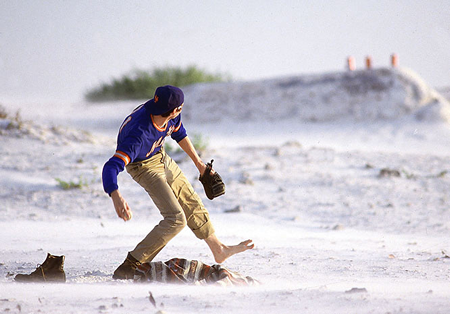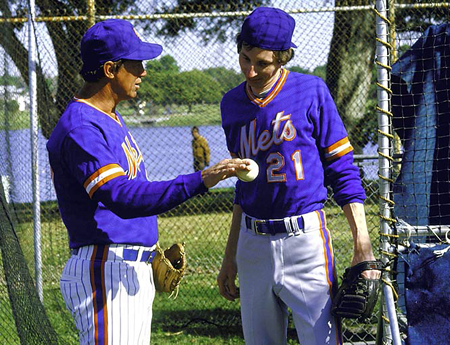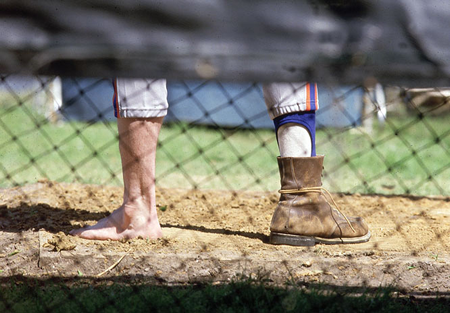“There’s no single sport that has the hold on our dreams and fantasies the way baseball does. Sidd has become a symbol, like the cornfield in Iowa.”
— Myra Gelband, former Sports Illustrated editor
_______________________
In an era when Hollywood was creating uniformed ballplayers walking out of cornfields and crushing majestic moon shots in to the New York City sky, the famed George Plimpton was busy crafting a fictional baseball character too: Hayden “Sidd” Finch.
He was born on April 1, 1985 by the hand (and mind) of Plimpton and, for at least a day, Finch was real. But, in reality, Sidd Finch was pure fiction. Plimpton’s intentions were clear: entertain the reader. If his intentions were to create a plausible baseball player he wouldn’t have dreamed up a 168-mile per hour fastball …
Or would he?
“If you read it carefully, some of the stuff is just ludicrous, not to mention, the speed of the ball,” said Lane Stewart, the former Sports Illustrated photographer assigned to illustrate Finch. “There are things in there you could never imagine that anyone familiar with sports could believe. Now, visually, I saw it as one shoe on, one shoe off. But there are a lot of things in there that give it away.”
The phenomenon the three young batters faced, and about whom only Reynolds, Stottlemyre and a few members of the Mets’ front office know, is a 28-year-old, somewhat eccentric mystic named Hayden (Sidd) Finch. He may well change the course of baseball history. On St. Patrick’s Day, to make sure they were not all victims of a crazy hallucination, the Mets brought in a radar gun to measure the speed of Finch’s fastball … the gun was handled by Stottlemyre. He heard the pop of the ball in Reynolds’s mitt and the little squeak of pain from the catcher. Then the astonishing figure 168 appeared on the glass plate. Stottlemyre remembers whistling in amazement, and then he heard Reynolds say, “Don’t tell me, Mel, I don’t want to know…”
It was just unbelievable. A ballplayer wearing an old workboot, tied above the ankle on his right foot and the nadir of his left limb completely bare. If Plimpton’s outlandish tale didn’t give it away then, clearly, Stewart’s photos would.
“The photo I took, one boot off, one boot on, is the best example,” said Stewart. “The contact between the feet and the surface is critical in sports. I just thought that anybody, anybody, that’s ever been involved with sports would look at that — one workboot not tied up, one boot off — and think this guy just ain’t real!
“I photographed that in so many different combinations … with uniform, with no uniform, with split uniform, with one boot off, with two boots on and totally barefoot. I fought against that selection of the picture as the opener because, I said, you’re gonna give it away in the opener. I was just dead set against it.”
Editors felt that was the way Plimpton scripted it, that’s what Sports Illustrated will publish. Besides, no one will actually believe it … Or would they?
THE BIRTH OF A PHENOM
It started with a simple meeting. In early 1985 Plimpton huddled in New York offices of Sports Illustrated with then managing editor Mark Mulvoy and articles editor Myra Gelband and created what publisher Robert Miller later described in a letter to readers as “a baseball player who had never been in the game at any level.”
Weeks later and minutes after Gelband received the first draft, Plimpton was on the phone.
“What do you think?” he asked.
Gelband read the article on the train home that evening and called Plimpton the next morning.
“Has Mark [Mulvoy] read it?” asked Plimpton.
“I’m giving it to him now,” said Gelband.
“Well, call me as soon as he reads it,” said Plimpton.
“George wants to know what we think of it,” Gelband told Mulvoy, passing off the manuscript. In the 2008 biography of Plimpton’s life “George Being George” Gelband said, “I don’t think I was even back at my desk yet when Mark called me, laughing.”
“I’m on page four,” he said.
“Keep going, it gets better,” said Gelband.
Stewart had spent more than two decades as a photographer at SI, including two “Sportsman of the Year” covers, by the time Plimpton’s outline landed on his desk.
“I was strictly a feature photographer,” he said. “A lot of my competitors used to say that I was the guy who photographed things that didn’t move. There’s a lot of truth to that. I’m not a sports fan. I am not an action photographer. I was an odd photographer for Sports Illustrated.”
It was Plimpton’s description of the fictional character Sidd Finch that lead Stewart to his friend and occasional assistant Joe Berton, a junior high school art teacher in Oak Park, Illinois.
Not only was Berton a baseball fanatic, he was a carbon copy of the fictional Finch.
“If you read Sidd Finch and you look at the pictures — it’s Joe,” said Stewart. “He (Joe) is a string bean, and what I didn’t know was, he has a really good pitching motion.”
 Stewart called Berton immediately and explained he had an assignment in St. Petersburg to photograph a new Mets pitcher. His name was Sidd Finch.
Stewart called Berton immediately and explained he had an assignment in St. Petersburg to photograph a new Mets pitcher. His name was Sidd Finch.
“I told Joe he’s (Finch) got a 168 mile per hour fastball, they’ve got him in a tent down their working under wraps,” said Stewart. “He won’t wear a uniform, he plays the French Horn and Joe’s looking at it as a Cubs fan. Joe’s thinking about the season.”
“Lane said he’s got a great fastball. I was excited about that because the Mets and Cubs were in the same division then,” remembers Berton, a lifelong Cubs fan.
“Are you in?” asked Stewart.
Of course Berton was in. Once he had confirmation, Stewart dropped the bombshell.
“There’s only one problem, you’re gonna be him!” blurted Stewart.
That’s when a series of bizarre requests surfaced in Mr. Berton’s applied arts class at Hawthorne Junior High School in Oak Park, Illinois. One student recalls Berton started asking to borrow “strange things.” One day it was a small, black baseball glove, the next day it was a French Horn, then a Tibetan food bowl.
Berton acquired the boots and the horn from a colleague in the music department, along with a “quick lesson on how to hold it to make it look realistic,” added Berton. Andrew Boies, a seventh-grade student at Hawthorne junior high, donated the black baseball glove, only after the magazine agreed to send him an SI swimsuit calendar.
Next stop: Al Lang Field, St. Petersburg, Florida, the spring training home of the 1985 New York Mets.
JUST ANOTHER ASSIGNMENT
“It was just another assignment,” said Stewart. “It wasn’t going to be a big deal. There was nothing the photography was going to do to make you believe it. It’s just a un-be-lieve-able story. We never tried to fool anyone.”
In hindsight, Stewart was never more wrong. With all due respect to Plimpton’s story, the 13 photos that appeared in the 15-page story were more than just a magazine companion. The images were the equivalent of throwing gasoline on a fire.
“To me, and Plimpton said this too, what really sold the story were Lane’s photographs,” said Berton. “That is Mel Stottlemyre. That is Lenny Dykstra. There’s Sidd. What sold it to the ballplayers is, they just looked at the pictures and said, ‘Geez, what’s with this guy?’”
“I’ve spent 59 days on pieces smaller than this,” said Stewart. “I’ve literally spent months on projects that didn’t run at all. I did a thing on Jim Thorpe where I went to nine cities in five states. This was just another assignment.”
Maybe so but Sidd Finch was more than just another Sports Illustrated story. Readers, league officials, players, fans and the media believed, even if it was for a moment or a day, they believed that Finch was real.
“The quotes were all created and that’s why I think people believed it,” said Stewart. “When you get general managers, sports editors, they get Sports Illustrated and they pick up an article like that and they start skimming down, they’re looking for the Stottlemyre quote. That’s what the professional reader, the true baseball fan, are looking for.”
Stottlemyre has been in direct charge of Finch’s pitching regimen. His own playing career ended in the spring of 1975 with a rotator-cuff injury, which makes him especially sensitive to the strain that a pitching motion can put on the arm. Although as close-lipped as the rest of the staff, Stottlemyre does admit that Finch has developed a completely revolutionary pitching style. He told SI: “I don’t understand the mechanics of it. Anyone who tries to throw the ball that way should fall flat on his back. But I’ve seen it. I’ve seen it a hundred times. It’s the most awesome thing that has ever happened in baseball.”
According to Stewart, Plimpton and Mets owner Nelson Doubleday were friends. “He (Plimpton) had carte blanche to make up quotes for everybody,” said Stewart. “He had the blessing of the owner and you can’t underestimate the ability of Plimpton being able to make up quotes.”
The Mets had issued an official team uniform to Stewart and Berton. “So I went down there with my ‘kit,’ my bag of costumes essentially and combined them with the Mets official uniform and we just set up a number of scenarios,” remembers Berton.
“The players had no idea what we were doing,” remembers Berton. “I think they just looked at us as being friends of Nelson Doubleday and don’t worry about it. But when you start playing a French Horn and start goofing around with Lenny Dykstra and Kevin Mitchell, Davey Johnson is looking down wondering, ‘What the hell is going on down there?’”
 “The organization was clueless,” confessed Stewart.
“The organization was clueless,” confessed Stewart.
The carefree attitude of the Mets public relations department only encouraged Stewart and Berton. The pair purchased rub on letters from a local hardware story in Florida and staged a shot in the Mets clubhouse. “We were able to manipulate the locker next to George Foster to make it look like Sidd Finch was right there,” said Berton.
Stewart just snapped away, taking photos of the empty locker. They later found a rooming house just blocks from the Mets complex, the site where Finch stayed in Plimpton’s tale. Remember the little old landlady who rented the boarding house to Finch in Florida? She’s real and, when asked by the magazine if they could use her name, she declined.
Again, Stewart and Berton set up and snap, snap, snap, more pictures.
Philip Stearns posed as the expert of Eastern religions. Henry W. Peterson, Finch’s fictional Harvard roommate was Jim Muuse, the son of an administrative assistant at SI. And the dormitory room at Harvard? Real. It belonged to Rob Hagebak, stepson to an SI art director.
Mel Stottlemyre was played by himself, as did Nelson Doubleday, Ronn Reynolds, Len Dykstra, John Christensen and Dave Cochrane.
As the sun rose on the shores of St. Petersburg, Stewart and Berton were setting up on the beach.
“I was looking in garbage cans because nothing was open,” remembers Berton. “We ended up finding a number of Coke cans, setting them up on the beach and they’d be lined up just like I was trying to plink off these Coke cans with a baseball. As it turned out, that’s the big photograph they used for the spread.”
“That picture (Finch on the beach) also hung outside the managing editors office for the rest of his career,” said Stewart, with a hint of pride in his voice.
‘MY GOD, WHAT HAVE I DONE?’
Monday, April 1, 1985.
Lane Stewart was shaving when the phone rang that morning. It was his wife calling from her office at Life Magazine. “The sports editor for Life Magazine just came in my office,” she said in a whisper, “and he wants to know how to reach Sidd Finch.”
“The words out of my mouth were … Oh s#$%!” remembers Stewart.
“The significance was that someone believed it and I never thought anyone would believe it,” Stewart said. “I was thinking, ‘My God, what have I done?’ You really don’t know what the consequences of something like this … you know? I was just a photographer. This ran for 15 pages. It was scheduled for five.”
Phones started ringing everywhere it seemed.
Peter Ueberroth, MLB commissioner from 1984-1989, received calls from two major league general managers. “When it hit the stands, they wanted to know what the hell was going on,” said Stewart, who met Ueberroth months after the story was published.
Meanwhile, blocks away in Manhattan, Daniel Patrick Moynihan was hearing the story for the first time. The New York Senator picked up the phone and called Robert L. Miller, then publisher of Sports Illustrated.
“Is this true?” Moynihan asked.
“Nobody told the managing editor this wasn’t important enough to tell the publisher,” said Stewart. “It just didn’t rise to that level that anyone would believe it.”
Miller was caught flat-footed and, according to Stewart, he told Senator Moynihan, “If it’s in Sports Illustrated, it must be true.”
Is it true?
His assigned roommate was Henry W. Peterson, class of 1979, now a stockbroker in New York with Dean Witter, who saw very little of Finch. “He was almost never there,” Peterson told SI. “I’d wake up morning after morning and look across at his bed, which had a woven native carpet of some sort on it—I have an idea he told me it was made of yak fur—and never had the sense it had been slept in. Maybe he slept on the floor. Actually, my assumption was that he had a girl in Somerville or something, and stayed out there. He had almost no belongings. A knapsack. A bowl he kept in the corner on the floor. A couple of wool shirts, always very clean, and maybe a pair or so of blue jeans. One pair of hiking boots. I always had the feeling that he was very bright. He had a French horn in an old case. I don’t know much about French-horn music but he played beautifully. Sometimes he’d play it in the bath. He knew any number of languages. He was so adept at them that he’d be talking in English, which he spoke in this distinctive singsong way, quite Oriental, and he’d use a phrase like “pied-à-terre” and without knowing it he’d sail along in French for a while until he’d drop in a German word like “angst” and he’d shift to that language. For any kind of sustained conversation you had to hope he wasn’t going to use a foreign buzz word—especially out of the Eastern languages he knew, like Sanskrit—because that was the end of it as far as I was concerned.”
Does that sound legit to you? A nap sack, hiking boots, a French Horn, speaking three or four languages at a time, sleep on “yak fur” and throwing a baseball 168 miles per hour … it was pure fiction.
“It never occurred to any of us that anyone would believe it,” said Stewart, still in amazement by the reaction. “There’s been a lot of talk, at the time and since because it’s become such a phenomenon, if you weren’t alive or part of this when it happened you don’t know what a phenomenon this was.”
By that afternoon, all three national television networks – ABC, NBC and CBS – were scrambling to put together stories. “You have no idea how big this was … we just didn’t talk about people believing it,” said Stewart. “It wasn’t a subject of conversation, at any point, any time.”
“It’s interesting see who believed that story and who didn’t, who fell for it and who didn’t,” said Stewart. “I had a real theory at the time, the people that really did believe it were the professional readers.
“The people who didn’t believe it were the kids, because they read the whole thing. If you read the whole thing, you didn’t believe it. If you just went through it and picked up the quotes, who the hell thinks Sports Illustrated is going to make up quotes from, of all people, Mel Stottlemyre? Who’s gonna put words in his mouth?”
LIFE, DEATH AND REBIRTH
“They had no idea the impact … it was just a story,” Stewart said. “But as quickly as it went up, it came back down. Within 24 or 48 hours it was over. It was a hoax.”
Letters to the Editor began pouring in to Sports Illustrated:
I have concluded that April Fools’ Day will come again, but not your magazine. Cancel my subscription immediately. — NICHOLAS V. LONGO, Yonkers, N.Y.
The Curious Case Of Sidd Finch should go straight into the Practical Joke Hall of Fame—without the usual mandatory five-year waiting period. — ROBERT P. DUGAN JR., Vienna, Va.
I’ve been Orson Welles-ed by George Plimpton and SPORTS ILLUSTRATED!
Congratulations on the greatest ruse since War of the Worlds. — MIKE SALTER, Santa Monica, Calif.
You lousy, rotten, good-for-nothing blankety-blanks. You got me hook, line and sinker—and I loved it. — MIKE LIDLE, Halifax, Pa.
Ha-ha. Cancel my subscription. — THOMAS GALLAGHER, Charlottesville, Va.
Haven’t we Met fans suffered enough? I submit that the article was cruel and unusual punishment. Couldn’t you have let Finch try out for the Yankees or Dodgers? – CHARLES E. GORDON, Winter Park, Fla.
Sidd Finch the phenom was dead and Sidd Finch the phenomenon was born (again). In the months after, Sidd Finch t-shirts were everywhere, the Mets held a Sidd Finch Day at the end of camp, a Sidd Finch-themed restaurant opened in Oakbrook, Illinois and every sports fan had a Sidd Finch story.
“For the generation of baseball fans that experienced this story, they come up to me and tell me their Sidd encounter and where they were when they read the magazine and how they responded,” said Berton. “Everybody remembers Sidd Finch. If I were the 12th pitcher on the Cubs, I’d have to get out an old baseball card to remind them.”
Local Chicago television stations converged on the school where Berton’s taught.
“They came out with a film crew and a radar gun and put me up in the high school gym and timed three of my pitches,” remembers Berton.
The best we got is 68 miles per hour,” said the reporter. “What have you got to say for yourself?”
In Plimpton’s fictional tale, Finch could throw 168 miles per hour.
“You need a new radar gun, the one on that one is burned out,” said Berton.
According to an unscientific list of the Top 100 April Fools Hoaxes of All Time, MuseumofHoaxes.com lists Sidd Finch No. 2, behind the infamous “spaghetti tree” hoax by the BBC in 1957.
But, for Berton, the most rewarding thing was the relationship he developed with Plimpton. “When he’d come to Chicago we’d get together and George would always love to hear the latest Sidd encounters,” he said. “He always just called me Sidd, even he had trouble believing a fictional character he created was really there in the flesh …”
Then he pauses.
“Your glove is down by the computer …” Berton says, his voice fading on the phone line.
“Sorry,” he says.
“We finally got a nice day here in Chicago so my son and I are getting ready to play catch.”
Sidd Finch is teaching his son how to pitch.
Go figure.
###
Photos courtesy of Sports Illustrated and Lane Stewart. To read George Plimpton’s story “The Curious Case of Sidd Finch,” visit the Sports Illustrated archives, click here.
EDITOR’S NOTE: This story was originally written by John Strubel, Lane Stewart of SI and Joe Berton to be published for the 25th anniversary. It’s being reprinted exclusively for Metsmerized Online readers.
















